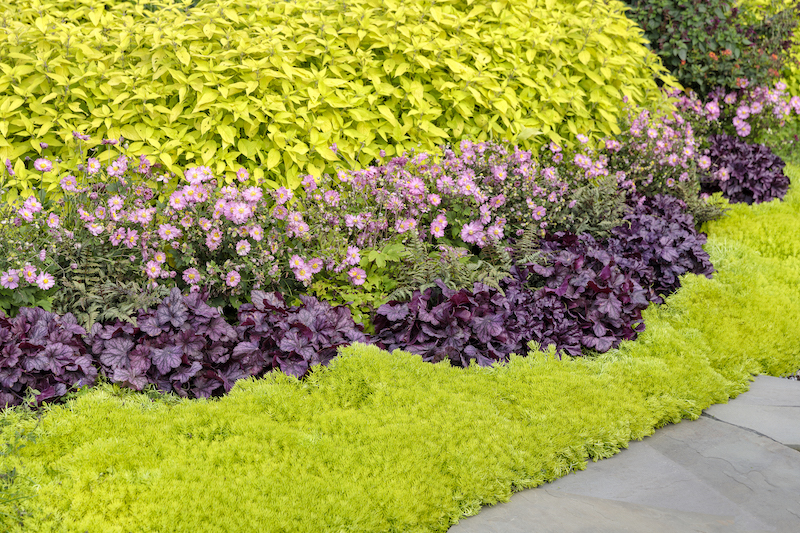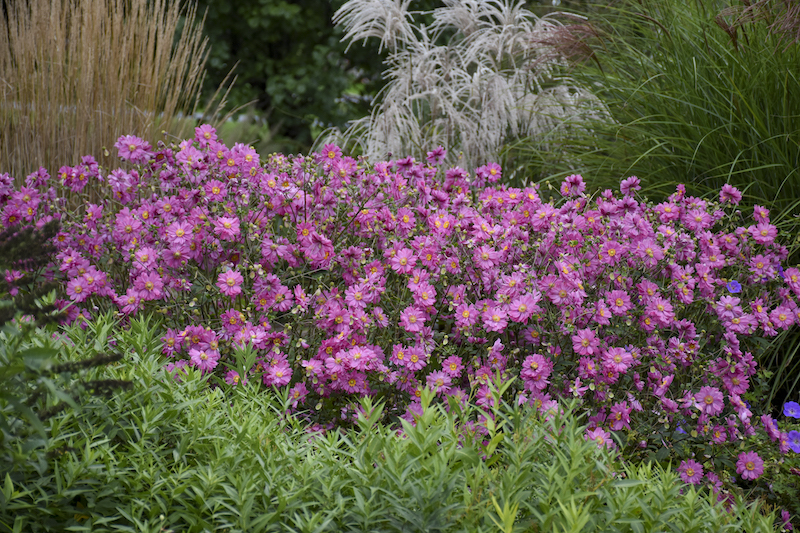Windflowers are one of the most delicate and lovely flowers to grow in the late summer garden. The tall flower stems gently blow in any breeze to add movement and interest when most other herbaceous perennials have finished for the season. Windflowers grow the tallest and strongest in well-draining soil that retains a consistent amount of moisture.
They appreciate supplemental fertilizing just as their flower buds form in mid-summer. Partnering windflowers with perennials and shrubs is easy to do as long as all of the plants grow in the same conditions.

Shrubs To Plant With Windflowers
Windflowers add movement and a touch of graceful elegance when planted amongst a shrub border. The tall flower and leaf stems hover over lower-growing shrubs and perennials. A wide range of flowering shrubs are perfect for growing as a backdrop for windflowers. Lilacs, forsythia, and mock orange bloom early in the spring well before windflower but their lush green foliage makes the perfect backdrop to highlight the later blooming perennial.
Broadleaf evergreens with colorful foliage can be grown for contrasting color and texture. Choisya, azalea, barberry, and nandina all make great partners and easy shrubs to grow. Late-blooming shrubs such as serviceberry, beauty berry, and butterfly bush can be added to enhance the windflower's long-lasting flowers.
Perennials To Plant With Windflowers
Even though most windflowers have a bloom time of late summer, the emerging new growth in the spring makes a lush backdrop to highlight early bloomers. Spring bulbs such as crocus, daffodils, tulips, lily of the valley, and hyacinths add much-needed color and flowers as the growing season begins.
Plant large-leaved plants such as daylilies, brunnera, and foxglove to provide color until the windflowers set buds. Japanese forest grass, other ornamental grasses, and ferns provide contrasting shapes and textures to elevate a design with windflowers. Late-flowering perennials like sedum, asters, and mums keep the garden in color even after the windflowers have finished.

Annuals To Plant With Windflowers
Depending on the look that you want to achieve, annual plants can be used in a couple of different ways. Low-growing annuals such as sweet potato vine, petunias, and ivy leaf geraniums look great as ground cover in front of a large planting of windflowers. Pansy and fuchsia can be used as edging plants in shadier spots or fillers at the beginning or end of the season when the temperatures are generally cooler.
Best Companion Plants For Windflowers in Containers
All types of windflower grow well in containers and look great as part of a seasonal mixed design. The smaller windflowers planted as a corm bloom late in the spring and are a reliable dose of bright color in a pot planted with layers of daffodils, tulips, and grape hyacinths. The taller Japanese windflowers can serve as the centerpiece in a mix of annuals and perennials. Plant petunias, calibrachoa, or dianthus as filler plants to bloom early, and use English ivy, licorice plant, or trailing verbena as the spilling element. Any combination of these plants will be stunning and easy to maintain. Fertilize lightly with a diluted liquid feed to keep the plants in bloom all summer long.
Plants Not To Grow With Windflowers
Do not pair windflowers with plants that prefer either very dry or wet conditions. Cacti, most succulents, and Mediterranean herbs (lavender, sage, rosemary, and thyme) need excellent drainage and lighter soil than windflowers. Windflowers prefer consistently moist, but well-drained soil. Pond and bog plants (cattails, waterlily, reed grasses, or marsh marigolds) need wet conditions and are not suitable companions for windflower.
Best Plants To Grow With Windflowers
When choosing plants to grow alongside windflowers, look for those that appreciate part shade to full sun and average soil with an acidic pH. Companion plants should also tolerate evenly moist, well-drained soil. For a spectacular combination, try layering pineapple sage as the backdrop, windflowers and coral bells as the mid layer, and low-growing, vividly colored sedum as the edging and ground cover. This combination of easy-to-grow herbaceous perennials will provide a long season of colorful interest in the garden.
 |
Author Robbin Small - Published 10-04-2023 |
